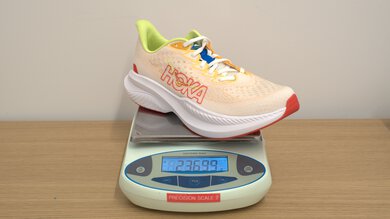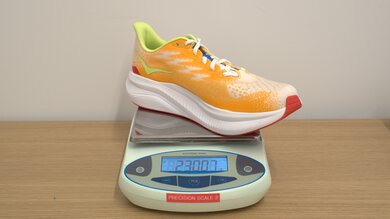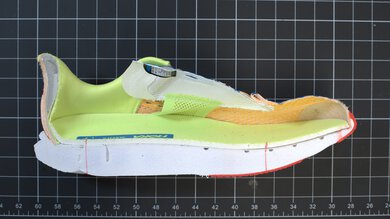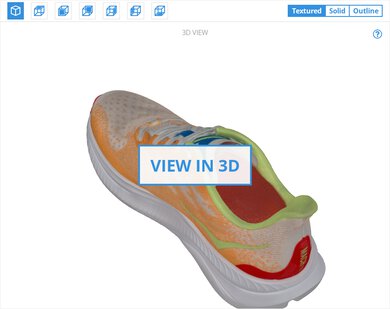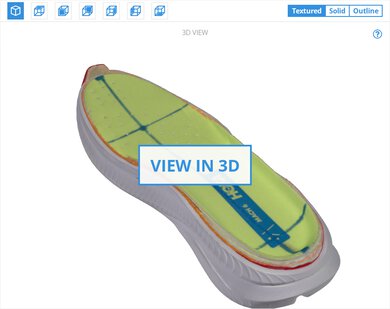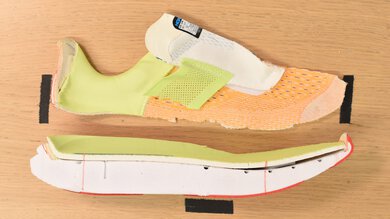The HOKA Mach 6 is a well-balanced daily trainer with features aimed at enhancing comfort while retaining a lightweight character. It has a new full-length 'supercritical' EVA midsole and added rubber outsole for a more reliable grip underfoot. The result is that it's a good jack of all trades but a master of none. While responsive, it doesn't quite match PEBA-based foams and carbon-plated options for fast workouts, and it's not as spongy and cushioned as a more maximalist daily trainer.
Our Verdict
The HOKA Mach 6 is mediocre as a marathon racer. While it's lightweight and has decent lateral stability, its cushioning and energy return are still sub-optimal for performance over long distances.
-
Especially lightweight for a trainer.
-
Decent stability for longer runs.
-
No plate.
-
Could be more cushioned.
For 5K and 10K races, the HOKA Mach 6 performs decently well. Its firm forefoot and reasonable weight make it suitable enough to handle shorter, faster races. However, its energy return is just okay, and without a plate, runners seeking a snappy push-off for top speed may find it falls short compared to specialized racing shoes.
-
Especially lightweight for a trainer.
-
Forefoot is firm.
-
No plate.
-
Could be more bouncy.
The HOKA Mach 6 provides adequate energy return. The responsiveness from the supercritical EVA foam is passable but not exceptional. This shoe won't dramatically enhance your stride efficiency or bounce, making it better suited to daily training or moderate-paced runs rather than races where superior responsiveness matters most.
-
Midsole returns a fair bit of energy for a trainer.
Cushioning in the HOKA Mach 6 is adequate but uneven. The forefoot cushioning is quite effective, providing good protection and comfort for mid to forefoot strikers. However, the heel cushioning is lacking, especially for heel strikers or runners on longer outings wanting more plushness and impact protection.
-
Good forefoot cushioning.
-
Heel cushioning is insufficient.
The HOKA Mach 6's lateral stability is decent. It offers reliable support thanks to its good width and firmness at the heel, which helps maintain balance and efficient foot strikes, especially on longer or fatigue-inducing runs. However, it's quite high stack and is narrower at the arch, reducing the overall stability.
-
Decent stability for longer runs.
-
Not especially wide outsole at the arch.
- 6.2 Marathon Racing
- 6.9 5K/10K Racing
Performance Usages
- 6.8 Energy Return
- 6.8 Cushioning
- 7.2 Lateral Stability
Changelog
- Updated Apr 02, 2025: Converted to Test Bench 0.8.
- Updated Apr 02, 2025: Review published.
Differences Between Sizes And Variants
We tested the HOKA Mach 6 in men's US size 9, as indicated on the label. The color we tested is White/Solar Flare, and the shoe is available in several other colorways, including Black/Electric Tangerine, Stellar Grey/Black, and White/Virtual Blue. There is also an Ironman Edition featuring M-dot graphics. Wide versions are available separately for both men and women. The design section applies only to the exact model we tested, but we expect other size and gender variants to perform similarly.
Additionally, the Mach LS Reformation Crochet/Monogram is an entirely different style, designed for lifestyle use rather than running.
Compared To Other Running Shoes
The HOKA Mach 6 is a lightweight, well-rounded daily trainer that appeals to runners seeking a more minimal feel for their daily mileage. It's positioned as a lighter, simpler alternative within the daily trainer category, offering a ride that's more agile than many competitors. However, those looking for greater cushioning or bounciness might find better options elsewhere—such as the softer, more protective Mizuno Neo Vista or the adidas Adizero Evo SL, which delivers significantly more responsiveness.
Within HOKA's lineup, the Mach 6 is designed primarily for runners who prioritize lightweight efficiency and a firmer feel on everyday runs. As a daily trainer, it's more well-rounded than the more basic HOKA Clifton 9. On the other hand, the HOKA Mach X 2 is a max-cushioned super trainer that offers even more versatility for a variety of workouts. For dedicated racing, HOKA offers specialized carbon-plated options like the HOKA Cielo X 2.0.
For more options, check out our recommendations for the best running shoes.
The HOKA Clifton 9 and the HOKA Mach 6 are both daily trainers, but each caters to slightly different preferences. The Clifton 9 is a more basic, reliable option, offering simplicity and stability for everyday mileage. The Mach 6, however, is more versatile thanks to its lighter weight, superior bounce, and more responsive cushioning. The Clifton is a good choice if you're looking for a straightforward workhorse. Still, for runners wanting more agility, responsiveness, and versatility in daily training, the Mach 6 will be the better pick.
The HOKA Mach X and the HOKA Mach 6 may share a name but serve distinct purposes. The Mach X is a versatile super trainer offering more cushioning and stability, making it suitable for easy mileage and faster-paced workouts. Meanwhile, the Mach 6 is a lighter and more classic daily trainer.
The HOKA Mach 6 and the ASICS NOVABLAST 5 are both versatile daily trainers but cater to different needs. The Mach 6 sits closer to the ground and offers a lighter, firmer feel, making it a great no-fuss option for daily training. In contrast, the NOVABLAST 5 provides significantly more cushioning, helping to protect your legs during longer efforts, and a midsole that delivers greater energy return.
The HOKA Mach 6 and New Balance FuelCell Rebel v4 are both lightweight daily trainers, ideal for runners who prefer a more nimble feel. The Rebel v4 is the lighter of the two, offering a more grounded and stable ride that feels secure underfoot. The Mach 6, while slightly heavier, delivers a more dynamic experience with a bit more bounce, making it feel livelier during runs.
The HOKA Mach 6 and the HOKA Mach X 2 share a name but cater to distinct running experiences. The Mach 6 is a lighter, lower-to-the-ground daily trainer that remains bouncy for its category. In contrast, the Mach X 2 is a more versatile super trainer. It features significantly greater cushioning and a plastic plate, allowing it to handle a wider variety of workouts and paces effortlessly. Overall, runners seeking versatility and maximum comfort for both daily training and faster sessions will prefer the Mach X 2, whereas those looking for a simpler, lighter daily option will find the Mach 6 appealing.
The Brooks Hyperion 2 and the HOKA Mach 6 are both lightweight trainers adept at picking up the pace. The Brooks is the lighter of the two, making it feel more agile, but the HOKA has better energy return and feels more cushioned underfoot, making it a bit more well-rounded.
Test Results
The HOKA Mach 6 feels light, making it comfortable and suitable for daily training and even occasional racing. Although not the lightest option, it strikes a good balance, providing an efficient feel without causing fatigue from unnecessary heft. However, runners prioritizing extreme lightness for competitive racing might prefer other models like the Nike Vaporfly 3.
The heel energy return on this model is okay. The shoe's midsole doesn't deliver impressive rebound at the heel, but it's actually energetic enough for a daily trainer. This is fine for casual runs but could leave performance-oriented runners feeling underwhelmed.
The forefoot energy return is moderately better but still not particularly exciting in the HOKA Mach 6. Runners landing on the front of their foot will experience decent but uninspiring responsiveness. This makes the shoe more suitable for general training than high-speed racing.
The heel of the HOKA Mach 6 is somewhat cushioned, offering moderate shock absorption. While the initial impression might feel adequate, the cushioning compresses too easily, especially for heavier runners or those putting in longer miles, potentially resulting in discomfort or fatigue during extended runs.
The forefoot cushioning initially feels comfortable and compresses well. However, during our real-world testing, we observed the forefoot consistently bottoming out on longer runs, leading to a harsh underfoot sensation. Thus, although cushioning is adequate for shorter recovery efforts, many runners will notice a significant drop in comfort over extended distances.
The heel midsole offers a firm feeling under lighter loads, providing solid stability for lighter runners. However, as the applied force increases—such as heavier runners or faster-paced impacts—the shoe feels a bit softer than other options like the Nike Vaporfly 41. Overall, it offers a good balance of softness and stability.
The forefoot foam remains consistently firm and supportive through a range of loads, providing good stability. The firm forefoot also helps for efficient and dynamic toe-offs when picking up the pace, especially for midfoot and forefoot strikers.
Comments
HOKA Mach 6: Main Discussion
Let us know why you want us to review the product here, or encourage others to vote for this product.
- 21010
How is the Alienware getting a 8.2 for Xbox Series and the Samsung that doesn’t support Dolby Vision gaming getting a 10 🤔
- 32120
I have to disagree when it comes to some of the Mini LEDs. I actually returned the dell here for the Innocn 32M2V based on bright room side by side performance. I wish there were more such panels from reputable makers as I don’t love the warranty.. but no burn-in worries and good-enough blacks with their FALD setup at half the price make it a killer offering. It was as low as $600 with a coupon a few days ago on amazon. I wish RTINGS would review it, but I can promise you it’s about as good as the 27M2V they did review, to my eyes. Only downside is slightly lower pixel density.
Contract ratio is terrible with the 32m2v
- 21010
Here’s a couple comparison shots that I was doing on an HDR video: https://ibb.co/Kr6kD4j https://ibb.co/NS9ttLQ In my opinion these photographs exaggerate the difference between the two but obviously the OLED on the right is superior in terms of blacks as you would expect
Generational difference
- 32120
I’m actually trying to choose between both of these monitors for my new monitor right now ! They’re both on my desk in fact . I don’t really like the curve of the OLED panel , and it’s just a tiny bit dim for me , however it is very pretty . Currently it seems to have some firmware bugs and at double the cost, it’s hard to justify it considering that the other monitor does pretty well except for perfect blacks. My guess is that what I really want is a miniled IPS panel , or at least a non curved OLED. Probably going to send the Alienware back and keep the G3223Q
That g3223q has major ips glow yikes!
- 32120
The Dell Alienware actually has worse/higher input lag than the tvs according to your testing. You mentioned that the Dell Alienware has lower/better input lag in your response. Maybe you got it backwards on your response? Like I said previously, that is kind of a surprising result for the new monitor to be quite a bit higher/worse with input lag than the QD-OLED tvs. Do you have any thoughts on that.
This has much lower input lag than the QD-OLED A95L.
- 2102-1
Unfortunately the 3rd gen improvements aren’t in brightness though. I’ve already used the 360hz qd-oled and it just wasn’t bright enough… amazing for movies, but not for competitive play. As for dolby vision… I find all those hdr formats to be overrated, especially hdr10+, I’ve only liked dolby vision on sony’s.
Dolby Vision gaming is a must and will be much more supported starting this year.
- 32120
Boring ): I’m sure this is someone’s endgame, but as someone who owns a S95B qd-oled, this new age of oled monitors is really leaves me wanting in comparison.
You will be wanting that Dolby Vision and 3rd gen QD OLED.
- 32120
My decision to opt for 1440p at 120Hz instead of 4k at the same refresh rate is primarily due to performance considerations. From my experience, and especially in highly competitive gaming scenarios like playing Apex Legends, every frame and millisecond counts. I’ve noticed a perceptible decrease in console performance when playing in 4k at 120 fps, which can impact reaction times and overall gameplay smoothness, factors that are critical in competitive gaming. My preference for 1440p at 120Hz is a balance between maintaining high visual quality and ensuring the console’s performance remains optimal for competitive play.
It’s the same performance on consoles
- 32120
Please check the edges of your test display with a flashlight. You’ll almost certainly see scratches and (residue/coating?) marks that can’t be removed. The hard bubble wrap taped to the monitor for packaging scratches up the outer panel layer. Seems like few of these Alienware monitors have make it out unscathed over the last 2 years. Pretty bad to see a product ruined by packaging mistakes. Lots of discussion in forums but no remediation from Dell, so the issue could use more attention. I have a lot on my 3225QF and I really wish this damage was covered by reviewers before I made the purchase :( Nearly a dozen threads like this on Reddit across different models: https://www.reddit.com/r/OLED_Gaming/comments/1ajl5uq/aw3225qf_panel_scratches_are_visible_with_the/ https://www.reddit.com/r/ultrawidemasterrace/comments/tbz7qv/new_aw3423dw_has_many_scratches_on_display/.
That’s the 1st thing to check and thankfully mine has none.
- 32120
eArc works great for me
- 32120
Can’t wait
- 21010
Are they going to review this?
- 54340
Please review this tv as it has pretty good specs for a LED/LCD.
- 10-11-1
For movie watching the Z9D.
- 10-11-1
currently 6
- 10-12-2
It doesn’t though. In real world viewing they are about the same brightness the motion, response time and input lag is significantly better on the X900H.
- 0-1-21-2
X900H looks NIGHT and DAY BETTER than the Nano 90. Blacks look black not gray, motion is faster/cleaner, it’s wayyyy brighter and the colors are much more accurate not to mention the much smoother UI!
- 2102-1
Yes both
- 10-11-1
1440p doesn’t show up when you hit the info button it will say 1080p but if you set it and notice a difference it’s 1440p.
- 2102-1
Completely wrong. Sony cheaped out on dolby vision. Sony uses a “low latency” dolby vision profile just like xbox one. It is a more simple version since their chipset isn’t powerful enough. So every external player has to implement this special profile to work on sony tvs since they went cheap with their chipsets for years.
Completely right and if you want a quality 4K/DV BR player don’t buy a cheap LG.
- 10-11-1
LG cheaped out with there 4K Blu-ray players and they don’t support Sony’s Dolby Vision profile. Not sure your price range but here are a few that do work.
Panasonic UB-820 Panasonic UB-9000 Sony UBP-X700 Sony UBP-X800M2 Sony UBP-X1100ES
My choice would be either Panasonic.
- 3213-1
Significantly better gaming performance,faster UI,better Dolby Vision and better motion than the 900F. Get the 900H
- 10-11-1
Mine is has no DSE,noticeable blooming or banding.
- 10-11-1
For gaming my choice is the X900H.
- 10-11-1
900H 65 inch and above is my choice.


